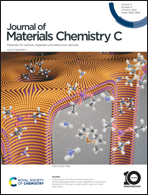Advanced atomic layer deposition (ALD): controlling the reaction kinetics and nucleation of metal thin films using electric-potential-assisted ALD†
Abstract
Ru thin films are grown using electric-potential-assisted ALD (EA-ALD), modifying the thin film growth behavior with an electric potential applied to the substrate. The generated electric field increases the (adsorption) rate of the precursor molecules onto the substrate, and thus the Ru nucleation density. As a result, the grain size and critical thickness for a continuous film decreases. In addition, the electric potential modifies the bonding energy of surface functional groups, which crucially affects the film growth behavior via, for example, the crystal orientation, grain size, and physical density. A negative bias decreases the surface Ru–O bonding strength, which enhances the surface reaction with the precursor molecules promoting the grain growth. However, a positive bias increases the surface Ru–O bonding strength, which impedes the grain growth resulting in small and uniform grains. Even though EA-ALD induces a higher oxygen concentration in the film due to the smaller size of the grains, the physical density of the film is higher. Consequently, an ultrathin (∼3 nm) and continuous Ru film with a low resistivity (∼40 μΩ cm) and a high effective work function (∼5.1 eV) is obtained.



 Please wait while we load your content...
Please wait while we load your content...